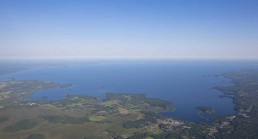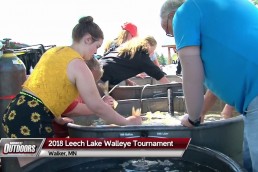SHARE THIS POST
Closure in July expected to help extend fishing season through Labor Day
Catch-and-release-only regulations intended to rebuild Mille Lacs Lake’s walleye population has been in effect since anlgers hit the water in mid-May. The 2017 walleye season on Mille Lacs is scheduled to run through September 4.
“Our goal is to have the longest fishing season possible while ensuring the conservation of the lake’s future walleye spawning stock,” said Tom Landwehr, DNR commissioner. “We understand catch and release is a difficult option for anglers who enjoy a fish meal, but we are using everything in our management toolbox to ensure a healthy and plentiful walleye population for future seasons.”
In addition to the catch-and-release regulation, and to help keep the walleye season open on Mille Lacs through Labor Day, the lake will have a 21-day walleye fishing closure from Friday, July 7-27. During that 21-day period, anglers can fish for all other species in Mille Lacs Lake including bass, muskies and northerns, but only with artificial baits and lures. An exception will exist for anglers targeting northern pike and muskellunge only and who don’t possess walleye gear. Those anglers may possess and use live sucker minnows longer than 8 inches.
The decision to have the three-week closure during the walleye season was made after a successful winter season on Mille Lacs, which drove walleye harvests to higher-than-expected levels.
“Ice anglers fished more on Mille Lacs in 2017 and caught more and larger walleyes than expected,” said Don Pereira, DNR Fisheries section chief. “As a result, ice fishing this winter accounted for about one-third of the total amount of walleyes state anglers can harvest from Mille Lacs in 2017.”
Several meetings and consultations with the Mille Lacs Fisheries Advisory Committee also aided the regulation decisions. Topics discussed between DNR staff and committee members included catch-and-release-only restrictions, season dates, live-bait restrictions and the reasons for the timing of the temporary summer closure.
“The plan is for this closure to coincide with the hottest part of the summer, when released fish are vulnerable to stress,” Pereira explained. “Warm water combined with July’s higher fishing pressure means that more fish die—even those that are caught and returned to the water.”
The tendency for caught fish to die after being released is called “hooking mortality,” which increases as water temperatures warm. During the last two weeks of July 2016 alone, hooking mortality accounted for more than half of the state’s walleye harvest allocation for the entire open- water season.
Are you enjoying this post?
You can be among the first to get the latest info on where to go, what to use and how to use it!
“These measures will extend the Mille Lacs walleye season as long as possible this summer and protect the younger walleyes the lake needs to rebuild its population,” Pereira said.
The state’s 2017 walleye allocation is 44,800 pounds. However, during discussions, state and Ojibwe tribal leadership established that the walleye season would remain open through 12:01 a.m., Sept. 5, provided the state harvest doesn’t exceed a conservation cap of 55,800.
Additionally, state and tribal leadership agreed to return to an overage system, through which each party will be required to deduct any harvest above its allocation from a future year’s allocation.
“Our next milestone for success is to observe another abundant year-class of walleyes,” Pereira said. “We need more than one year when a lot of walleye hatch. What we need to see is large numbers of walleyes surviving beyond the first year to add more spawning fish to the population. We’ve not seen that yet.”
Pereira said the DNR is committed to maintaining the Mille Lacs area as a premier fishing destination. He said the agency is conducting a comprehensive review of its data-collecting methods in order to ensure the most accurate information possible is being used. For example, Michigan State University fisheries experts are now reviewing the agency’s creel-survey methods.
Mille Lacs continues to make headlines for its nationally recognized smallmouth bass and muskie fisheries. For example, the Toyota Bassmaster Angler of the Year Championship is returning to Mille Lacs this fall for the second consecutive year. Last year, some of the nation’s top competitive anglers referred to the lake as a “world-class smallmouth bass factory.”
In addition to fishing, Mille Lacs offers numerous recreational activities including boating, waterskiing, swimming, canoeing, kayaking, paddle boarding and sunbathing at the public beaches.
“Mille Lacs is a premier tourism destination with diverse fishing and a whole lot more,” said John Edman, director of Explore Minnesota, the state’s tourism arm. “The area additionally offers lots of ways outdoor enthusiasts can enjoy the area’s natural beauty on hiking, biking and ATV trails, watching wildlife, golfing or visiting a Minnesota state park.”
For more information…
More information on Mille Lacs’ ongoing DNR management, research and area recreation opportunities, visit the DNR website at mndnr.gov/millelacslake.
MWO
SHARE THIS POST
Did you enjoy this post?
You can be among the first to get the latest info on where to go, what to use and how to use it!
MWO
We believe being outdoors is good. With more than 1,000 articles each year, MidWest Outdoors magazine is all about sharing outdoor experiences with you—where to go, what to use and how to use it… whether you’re close to home or on that trip of a lifetime.



